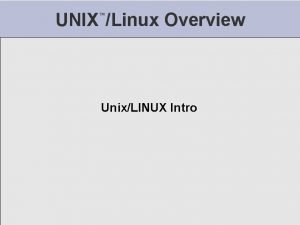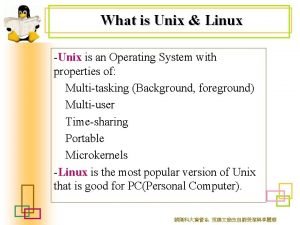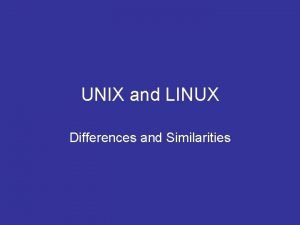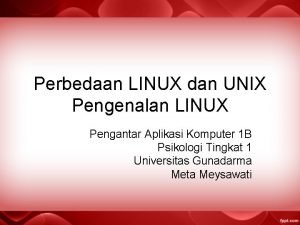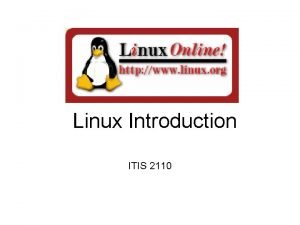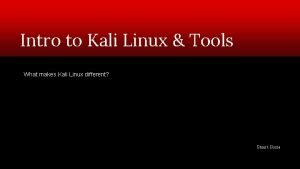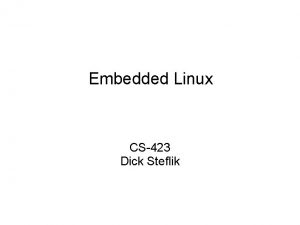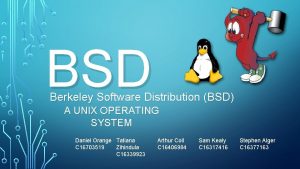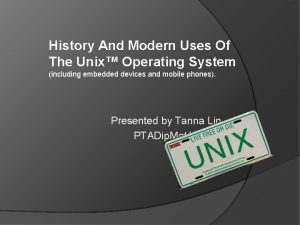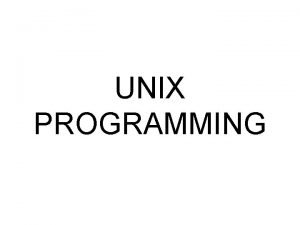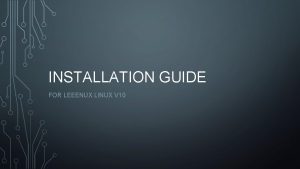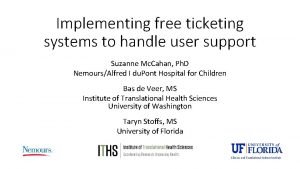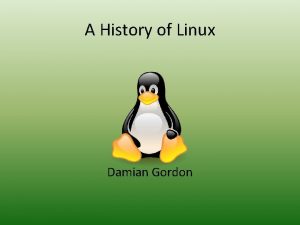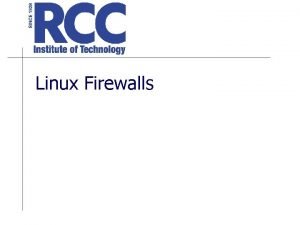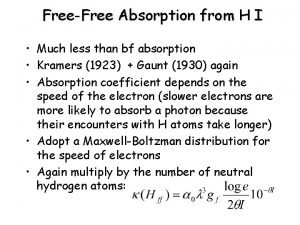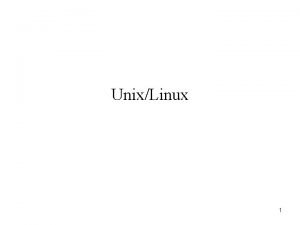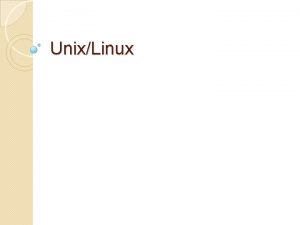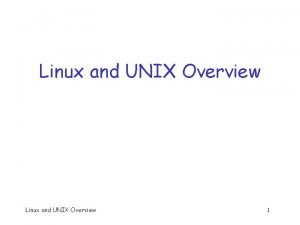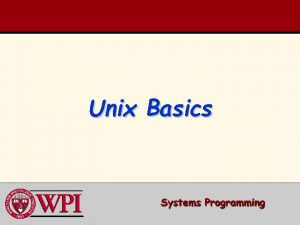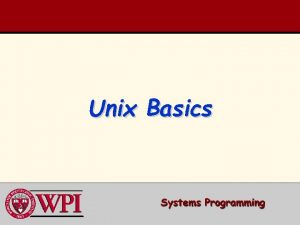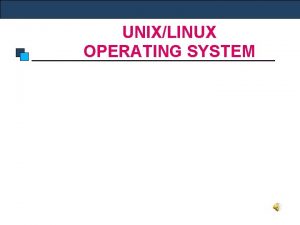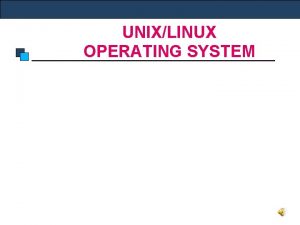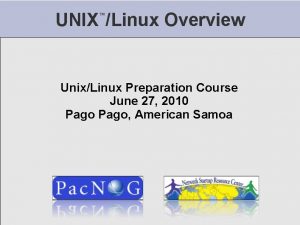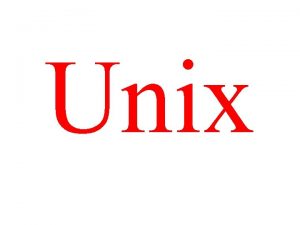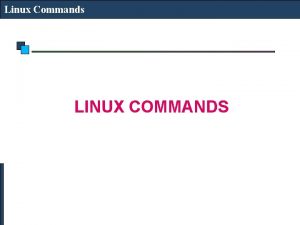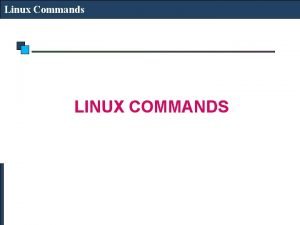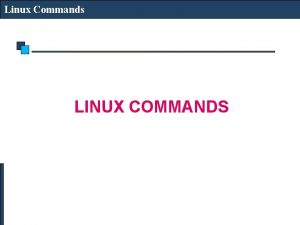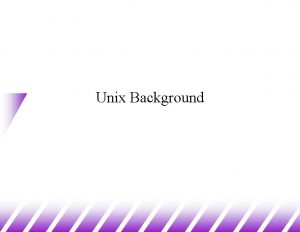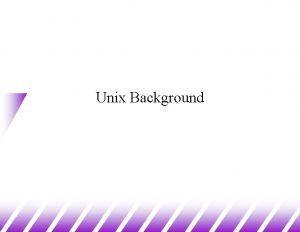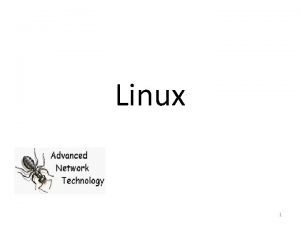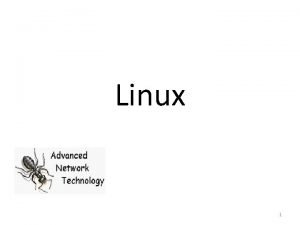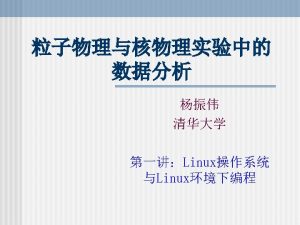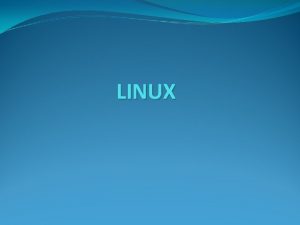UNIX Linux Overview UnixLINUX Intro UNIXLinux History Free


























- Slides: 26

UNIX /Linux Overview ™ Unix/LINUX Intro

UNIX/Linux History

Free. BSD Timeline Image courtesy of Wikipedia

Free. BSD Timeline Image courtesy of Wikipedia

Ubuntu Timeline Image courtesy of Wikipedia

Unix and Linux Are they the same? Yes, at least in terms of operating system interfaces Linux was developed independently from Unix is much older (1969 vs. 1991) Scalability and reliability Both scale very well and work well under heavy load (this is an understatement ) Flexibility Both emphasize small, interchangeable components Manageability Remote logins rather than GUI Scripting is integral Security Due to modular design has a reasonable security model Linux and its applications are not without blame

UNIX / Linux and Windows Why use UNIX / Linux? It’s what the Internet uses to provide core services 60% of all web servers are running Apache Much of Enterprise class computing built around UNIX / Linux Open Source network monitoring and management solutions - Widely used - Generally not available for Windows Router OSes are command-line and some, even, Linux We assume End users are on Windows (some places Macs, too) Don’t expect end-users to use UNIX or Linux We do expect that you are likely to use Linux or UNIX Licensing Windows products cost $$ Open Source software is “free” (as in beer) Actual costs to implement vary widely

The Unix System Simplified

The Unix System More Detail

The Kernel • The "core" of the operating system • Contains device drivers - Communicate with your hardware - Block devices (physical media – hard drive, CD, RAM) - Character devices (keyboards, mice, terminals, modems) - Network devices (network cards) - Pseudo devices (/dev/null, /dev/random) • Filesystems - Organise block devices into files and directories - ufs 2, ext 3, ext 4, reiserfs, jfs, zfs

Shells Command line interface for executing programs • Windows equivalent: command. com or command. exe Also programming languages for scripting • DOS/Windows equivalent: batch files, WSF, VBScript Choice of similar but slightly different shells • sh: the "Bourne Shell". Standardised in POSIX • csh: the "C Shell". Not standard, but includes command history • bash: the "Bourne-Again Shell". Combines POSIX standard with command history. • Others: ksh, tcsh, zsh

User processes The programs that you choose to run Frequently-used programs tend to have short cryptic names (due to early memory limitations) "ls" = list files "cp" = copy file "rm" = remove (delete) file Lots of stuff included in most base systems Editors, compilers, system admin tools Lots more stuff available to install as well Thousands and thousands of packages

System processes Programs that run in the background; also known as "daemons" Examples: “sparky” cron: Executes programs at certain times of day syslogd: Takes log messages and writes them to files inetd: Accepts incoming TCP/IP connections and starts programs for each one sshd: Accepts incoming logins sendmail (other MTA daemons like Exim, Postifx): accepts incoming mail (smtp)

Security model Numeric IDs user id (uid 0 = "root", the superuser) group id supplementary groups Mapped to names in plain text files /etc/passwd /etc/group Suitable security rules enforced e. g. you cannot kill a process running as a different user, unless you are "root"

d Core directory refresher / /var /usr /tmp /home (/boot, /bin, /sbin, /etc, maybe /tmp) (Log files, spool, maybe user mail) (Installed software packages) (May reside under “/”) (user’s home directories reside here) Don't confuse the “root account” (/root) with the “root” (“/”) partition.

‘Auto Defaults’ Partition Free. BSD During Free. BSD installation you can choose this option. It creates the following: • “/” Small Root partition - this will contain everything not in another partition /bin, /sbin, /usr etc. • A swap partition for virtual memory • /var - For “variable” files, such as logs, mail spools, etc. • /tmp - Where temporary files are located • /usr - /usr/home contains user directories. This is the largest partition created. In Linux this is just /home.

Partitioning Issues /var may not be big enough, especially if you are running a busy service like a Proxy server that logs all transactions, a busy web or email server /usr contains OS utilites, third-party software /usr/home contains your own important data If you reinstall from scratch and erase /home, you will lose your own data. Typically, /usr will be your largest partition Please read: http: //en. wikipedia. org/wiki/Filesystem_Hierarchy_Standard

Note. . . Partitioning is just a logical division If your hard drive dies, most likely everything will be lost. If you want data security, then you need to set up mirroring with a separate drive. Another reason to keep your data on a separate partition, e. g. /u Remember, “rm -rf” on a mirror works very well. Or, as always “Data Security” <==> Backup

Software Installation Free. BSD Software management in Free. BSD • • • Install from source Install from binary Compile from source using a port Use a wrapper tool, such as portinstall. Install pre-built Free. BSD packages using pkg_* or the new pkgng You can keep the source tree local and up-to-date. This is known as the ports collections. A number of tools to do this, including portsnap.

Ubuntu Software management • dpkg --get-selections, dpkg-reconfigure, dpkg-query! • apt - apt-cache, apt-cache policy, apt-cache search apt-get, apt-get install, apt-get remove, apt-get purge, aptget clean ! - $apt-get install screen • aptitude - aptitude search, aptitude clean, aptitude remove, aptitude purge!

System Startup Free. BSD Startup scripts in Free. BSD • /etc/rc. d – system startup scripts • /usr/local/etc/rc. d – third-party startup scripts Controlling services • In /etc/defaults/rc. conf – initial defaults • /etc/rc. conf – override settings here

System Startup Ubuntu Startup Scripts • In /etc/init. d/ (System V) • In /etc/init/ Controlling services • update-rc. d(default method) • Stop/Start/Restart/Reload/Status Services # service <Service> <Action> or, “old school # /etc/init. d/<service> <action>

Free. BSD Administration • The use of the root account is discouraged. The sudo program is used instead. • You can do a “buildworld” to move between major and minor releases (Free. BSD) • You can also use freebsd-update procedure to do security updates or major updates. • This is means its possible to “jump” from Free. BSD 9. 2 to Free. BSD 10 with a few commands

Important Reads • • • man builtin man hier man man ports man rc. conf And, “man any_unknown_command” when you are in doubt.

Key Advantages of Free. BSD • The ports system • One of the best package managers available on any operating system • Resolves Dependencies, easy to update • Thousands of softwares available • The /etc/rc. conf file • Start all services from one location • Set system startup details like IP Address, hostname etc • Configure automatic repair at boot time • Flexibility, speed, reliability • Its rock solid • Fast – can be tuned for specific services • Very reliable – failures often due to hardware not the software

There's More The Free. BSD Handbook http: //www. freebsd. org/handbook/ Free. BSD Resources http: //www. freebsd. org http: //forums. freebsd. org http: //www. freshports. org/ http: //wiki. freebsd. org http: //en. wikipedia. org/wiki/Free. BSD http: //en. wikipedia. org/wiki/Ubuntu_%28 operating_system%29 http: //en. wikipedia. org/wiki/Filesystem_Hierarchy_Standard
 Unixlinux
Unixlinux What is unix
What is unix Differnce between unix and linux
Differnce between unix and linux Linux disusun berdasarkan standar sistem operasi
Linux disusun berdasarkan standar sistem operasi Linux distribution timeline
Linux distribution timeline What is the difference between unix and linux
What is the difference between unix and linux Armitage metasploit
Armitage metasploit Kernel linux security module m1 support
Kernel linux security module m1 support Cs423
Cs423 Bsd berkeley software distribution
Bsd berkeley software distribution History of unix os
History of unix os Bsd unix history
Bsd unix history History of unix
History of unix Unet bootin
Unet bootin Phanindra sama wiki
Phanindra sama wiki Linux 1992
Linux 1992 Linux login history
Linux login history Linux kernel history
Linux kernel history Gibbs free energy
Gibbs free energy Boltzmann entropy equation
Boltzmann entropy equation Gibbs free energy unit
Gibbs free energy unit Kernel dynamic memory
Kernel dynamic memory Helmholtz free energy and gibbs free energy
Helmholtz free energy and gibbs free energy Happy isles ulysses
Happy isles ulysses The story of an hour summary
The story of an hour summary Free free absorption
Free free absorption History also history physical
History also history physical
